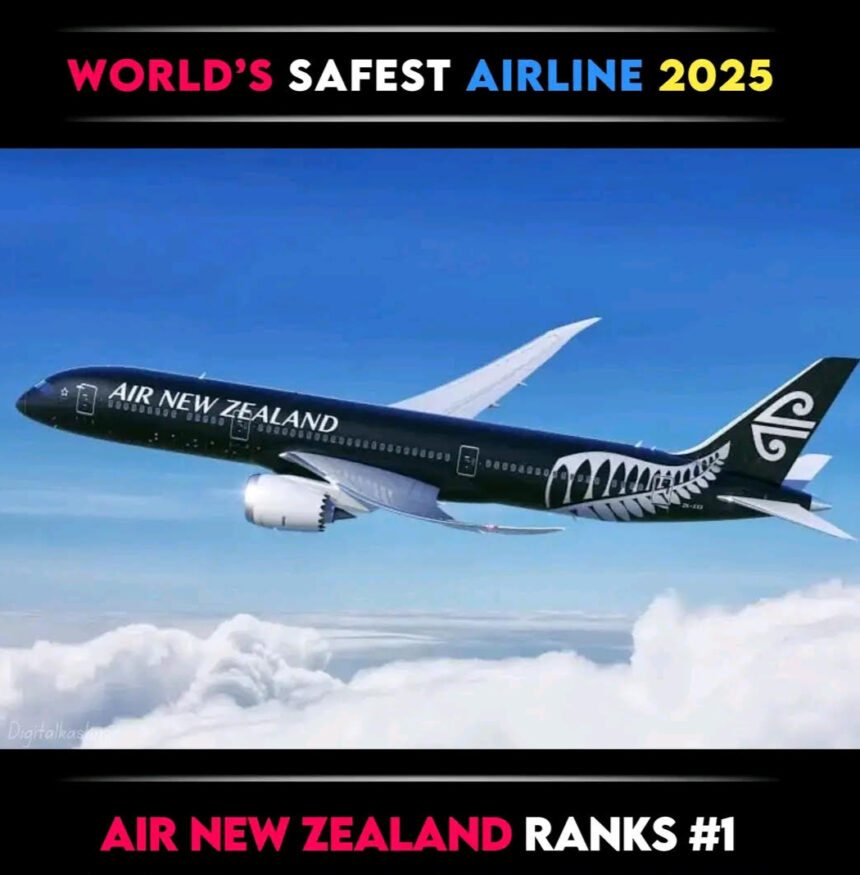Airline safety rankings matter more than ever. They build trust with travelers and show which airlines put safety first. In 2025, Air New Zealand has claimed the top spot around the world, outshining 385 other carriers. This achievement cements its reputation as one of the safest airlines to fly. But how did they reach this level? What makes Air New Zealand a leader in safety? Let’s find out.
Air New Zealand’s Leadership in Airline Safety in 2025
Overview of the 2025 Safety Ranking
The 2025 ranking was put together by several independent aviation safety organizations. They examined over 385 airlines across different safety areas. Their scoring looks at factors like past safety records, compliance with international rules, and latest safety practices. Achieving #1 out of so many competitors shows Air New Zealand is miles ahead in safety measures and reliability.
Historical Context and Consistency
Air New Zealand’s safety record isn’t new. The airline has long been known for strict safety standards. Compared to previous years, the airline has improved steadily. It has kept its safety ratings high for more than a decade. This consistency shows a strong commitment to keeping travelers safe forever. It isn’t just a flash in the pan; it’s a true safety leader.
Factors Contributing to Air New Zealand’s Top Safety Ranking
Robust Safety Management Systems
Air New Zealand invests heavily in safety systems. They use advanced protocols to prevent accidents and monitor risks in real time. Their staff regularly trains with the latest safety drills. They even have safety checks at every stage of their operations. These efforts create a strong safety net for every flight.
Airline Industry Regulations and Compliance
Staying on top also means following strict rules. Air New Zealand complies with international standards from ICAO and IATA. They undergo frequent audits and certification checks. Meeting these industry benchmarks proves their safety is rock solid. Compliance isn’t just about rules — it’s about setting the best standards in the air.
Airline Fleet and Maintenance Practices
Having a modern fleet is key to safety. Air New Zealand upgrades its planes regularly, making sure every aircraft is up-to-date. The airline follows rigorous maintenance routines to catch issues early. When you fly a well-maintained plane, your safety is greatly improved. These precautions make a big difference.
Safety Culture and Leadership
The airline’s leaders prioritize safety above all. They foster a culture where staff report problems without fear. Transparency is key to avoiding accidents. Experts say that leadership setting a safety-first tone influences everyone on board. Strong safety culture can prevent issues before they happen.
Technological Innovations Elevating Air New Zealand’s Safety
Integration of Artificial Intelligence and Data Analytics
AI is changing how airlines prevent accidents. Air New Zealand uses AI for predictive maintenance. The system spots possible issues before they turn serious. Data analysis also helps identify risky patterns, so they can intervene early. These tools save lives by catching problems before they happen.
Enhanced Passenger and Crew Safety Technologies
Onboard safety gets smarter too. Air New Zealand introduces new cabin features to keep passengers secure. Smart cockpit systems automate routine checks, reducing human error. These innovations help pilots and crew respond faster during emergencies.
Future-Forward Safety Investments
The airline continues to look ahead with new safety projects. They partner with tech firms to develop safer aircraft and better safety apps. Their ongoing commitment to innovation makes sure safety keeps improving. Staying ahead of risks is part of their game plan.
Industry Recognition and Its Impact on Consumer Confidence
Global Trust in Air New Zealand’s Safety Standards
Travelers now see Air New Zealand as a top choice for safety. Many surveys show high confidence in their safety standards. Media outlets also highlight their recent ranking victory. When an airline is ranked #1 globally, it boosts traveler trust significantly.
Marketing and Brand Positioning
Air New Zealand uses its safety record in marketing. Ads stress their safety leadership. This strategy helps attract new customers and keeps loyal ones reassured. It’s a powerful way to show passengers they’re flying a safe airline.
Practical Tips for Passengers
Want to ensure a safe trip? Check recent safety rankings before booking. Always follow safety instructions onboard and pay attention to crew messages. Safe airlines care about your well-being from check-in to landing.
Challenges and Future Outlook for Airline Safety
Navigating Ongoing Industry Risks
Cyber threats continue to grow. Airlines like Air New Zealand address those risks with strong cybersecurity. External shocks, like pandemics or climate events, remain a challenge. Staying prepared is vital for safe flying.
Continuous Improvement and Innovation
Safety standards evolve constantly. Airlines need to adapt quickly to new rules and technology. Implementing sustainable practices also supports safety. A safe airline looks to the future with fresh ideas and ongoing training.
Expert Insights
Aviation safety experts agree that innovation is key. They believe the focus will shift more toward automation and data use. Air New Zealand’s lead in safety might inspire others to raise their standards too.
Conclusion
Air New Zealand has proven itself as the safest airline in the world for 2025. This achievement didn’t happen by chance. It’s the result of strict safety measures, innovative technology, and strong leadership. Travelers can now fly with even more confidence knowing that safety is a top priority. Airline safety rankings are more than just numbers—they’re a promise. When you pick an airline like Air New Zealand, you’re choosing peace of mind every time you take off.

